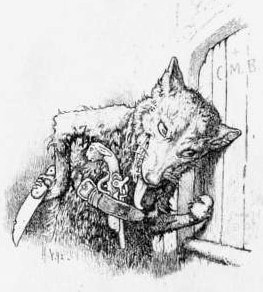|
There was no real concerted effort to start recording folktales until about the 19th century. However, collectors like the Grimms insisted that their stories were ancient. They were recording traditions that went far back into history. However, the school of thought later drifted towards the idea that the stories were all fairly modern. However, this has now switched course. During one period, some folklorists fell into the trap of drawing similarities based on surface resemblances. Tom Thumb and Tam Lin have similar names, so they must have originally been the same character. Shakespeare's tiny fairy Mab and the Irish goddess Medb are visually similar names, so they must be the same character. (Never mind that Medb is pronounced more like Meave.) But what we should really look at are the elements of the story. The Italian story of Giovanuzza the Fox includes neither cat nor footwear, but it's clearly the same story as Puss in Boots. It's possible to have a Red Riding Hood tale with no mention of the iconic red hood. Instead of a wolf, there could be a tiger. Sara Graça da Silva and Jamshid J. Tehrani, in their study of ancient fairytales, suggest that Red Riding Hood and the story of the Seven Kids share a common ancestor. Aglaia Starostina identified stories from a 9th-century Chinese manuscript as analogues of Sleeping Beauty. Spindles and shuttles? No. A young woman fated to "die" only to be revived? Yes. Syair Bidasari, a Malay poem probably from around 1750, has similarities to Snow White. Scholars also find fairy tale motifs buried in ancient mythology. Iona and Peter Opie, in Classic Fairy Tales, compared Red Riding Hood's dialogue with the wolf ("What big eyes you have, Grandma!" "All the better to see you with") to the story of Thor and the giants in the Elder Edda, where he impersonates a bride in order to steal back his hammer. "Why are Freyja's eyes so ghastly?" asks Thrym, catching a glimpse of them beneath her veil. "It is because she has had such a longing to see you," replies Loki, "she has had no sleep for eight nights." My go-to fairytale, Tom Thumb, is hard to trace back before, well, "Tom Thumb," a 17th-century British chapbook. However, elements go back far into the history of storytelling. The Greek myth of Kronos and the story of Jonah both describe a person being swallowed but surviving and escaping. The Greek god Hermes, much like Thumbling, starts driving cattle on the very day he's born. Japanese mythology has the tiny god Sukunahikona (appearing in the Kojiki, possibly the oldest surviving Japanese literary work), and the legend of Princess Kaguya, a tiny baby girl discovered by a childless couple. This--and the Japanese version of Tom Thumb, Issun-boshi, also being very old--makes me wonder if the story originated in Asia. Graham Anderson's Fairytale in the Ancient World looks specifically for fairytale motifs appearing in ancient myths. Anderson mentions a scene in Petronius' Satyricon, a novel from the 1st century AD, where someone remarks, "the man who was once a frog is now king." That seems like a reference to the Frog Prince. Anderson finds ancient connections to Cinderella, Snow White, Beauty and the Beast, Rumpelstiltskin, and many other stories. In some cases, the connections feel like a stretch - like pulling together different strands of Greek myth to suggest that a nymph named Chione (Snow) was an early Snow White and Artemis played the part of her murderous stepmother. In others, there are some compelling coincidences. In a 2nd-century Greek novel, a convoluted tale features a woman named Anthia (flower) who fakes her death, and Anderson suggests that this was a pragmatic adaptation of Snow White. A few people have sent me links to Da Silva and Tehrani's study, and it is fascinating - although it took me forever to figure out what they were actually doing, and I may still be grossly oversimplifying it. They used phylogenetics, the study of language. If two different languages both have an example of, say, Hansel and Gretel, then there's a good chance that you can trace the story back to the nearest common ancestor of both languages. The farther back that common ancestor, the older the tale. The story they trace back the furthest is ATU 330, ‘The Smith and the Devil,' possibly existing as far back as the Bronze Age. In this story, a smith makes a deal for his soul with an evil being, but then tricks the being. That feels like guesswork to me. Still, you need some guesswork when dealing with oral tales that were not written down until centuries later. This study has been criticized for biases and a sample size which is much too small and Europe-centric (see the letter by D'Huy et al). However, the authors responded to say they were aware of the limited sample size and had acknowledged this shortcoming in their paper, arguing that critics overlooked their actual points. Another tale that has been pointed out by other scholars as particularly ancient (in that they can trace back recorded versions to Ancient Egypt) is the "Tale of Two Brothers." Sources
Text copyright © Writing in Margins, All Rights Reserved
0 Comments
Leave a Reply. |
About
Researching folktales and fairies, with a focus on common tale types. Archives
July 2024
Categories
All
|
Writing in Margins

 RSS Feed
RSS Feed
